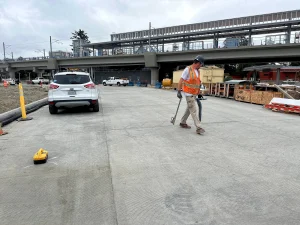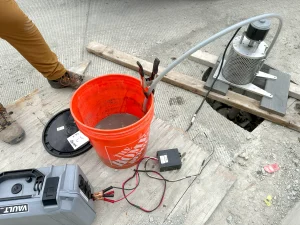
Imagine an average commercial shopping plaza in the early 1990s, and your mental picture will probably include a small dry-cleaning operation. Many of the seemingly innocuous cleaners in our strip malls were utilizing a chemical called tetrachloroethylene, or PCE, in their processes. PCE, known for its stellar cleaning abilities and stability, was the solvent of choice for the dry-cleaning industry for many decades. However, it poses a significant threat if released into the environment.
Across the country, many former dry cleaners have left PCE contamination behind in soil and groundwater. Environmental agencies like the Washington Department of Ecology are working to investigate, characterize, and clean up these sites—and environmental engineers like me help them do it.
Project Overview

In 2017, GeoEngineers started an investigation at the site of a former dry-cleaning business where PCE had been found. The goal was to assess soil and groundwater conditions in anticipation of an upcoming acquisition and future redevelopment plans. As part of this process, remedial investigations were conducted due to the levels of chlorinated solvents in the groundwater. In September 2024, we further evaluated the extent of contamination downgradient of the site.
This project is an excellent example of remedial investigations and the important role that groundwater monitoring and sampling play as environmental engineers and environmental geologists’ work to understand the scale and scope of subsurface contamination at similar sites across the country. Join me for a first-person look at groundwater sampling and how it helps us understand, and eventually clean up, sites like this one.
Location and Drilling

Our project kicked off with a crucial task—pinpointing the perfect spots for our monitoring wells, strategically located downgradient from the main contamination source (the former dry-cleaning business). By placing the monitoring wells correctly, we can determine how far contamination might extend, and in what concentrations. The added complexity of working on an active construction site made siting quite a challenge!
Once we had our locations marked, it was time to roll up our sleeves and drill. Using hollow stem augers, we carefully installed monitoring wells reaching depths of 40 feet. Why 40 feet? We wanted the wells to sit on the top of a confining silt layer that was approximately 40 feet below the ground. Once those wells tapped into the groundwater and installed on top of a confining silt layer, they began to dance in harmony with the flow—driving deeper into the earth due to their weight compared to water. With the well screens installed at the bottom 20 feet of the well and groundwater successfully drawn, it was time to prepare the well for taking samples!
Well Development

After drilling, it’s time to ensure our monitoring wells are in pristine condition. Well development is the process of clearing out any silt or fine particles introduced during drilling, as well as those in the aquifer surrounding the well screen. To achieve this, we employ different pumps (such as the powerful Typhoon Pump and efficient Roto Pump) to reduce the turbidity of the well water to below 500 NTU. This clarity enables us to minimize sediment extraction during sampling and establishes a direct connection between the well and the aquifer.
Underground Snapshots

Once our wells have undergone the meticulous well development process, it’s time to capture a snapshot of the groundwater conditions. Following a 72-hour resting period, we’re ready for sampling. There are a variety of pumping techniques available, but for this project our preferred method used a bladder pump and low-flow purge sampling technique. By stabilizing key parameters such as pH, dissolved oxygen, conductivity, and temperature, we ensure that the water is in equilibrium with its surroundings. This approach, with a controlled pumping rate of 0.5 liters per minute, enables us to obtain samples that authentically represent the formation water, providing valuable insights into the site’s environmental conditions.
Interacting with multiple contractors on the site posed a unique dynamic and made careful communication particularly important. Although not a significant challenge, maintaining open channels with fellow companies was an exercise in coordination. Effectively communicating with drillers and overseeing health and safety protocols, although usually well-managed, required diligent attention to detail. Thanks to high contamination levels at this site, some of the soil and groundwater material was classified as Investigative Derived Waste (IDW), which required careful handling and permitted disposal in accordance with regulatory requirements.
Interpreting Subsurface Data

Despite the challenges, we collected some intriguing data. We observed how water levels exhibited significant variances within a mere 15-20 feet of distance, shedding light on the dynamic nature of groundwater in the area. These fluctuations not only impacted groundwater characteristics but also had discernible effects on the concentrations of contaminants we were monitoring. The data we collected will be carefully analyzed by the rest of our environmental team, and the picture it paints of subsurface contamination—location, concentrations, and even dynamic changes in the aquifer—will be used in the development of an eventual remedial action plan to clean up the site.
Data-Informed Decisions

Groundwater monitoring programs are one of the most common, and critical, data-collection methods for environmental engineers. When developed and maintained correctly, monitoring wells can continue to provide reliable information about subsurface conditions for years as contamination is treated or removed. High-quality data should always be at the foundation of our work, and for environmental engineers like me—that means a lot of well development and a lot of sampling!
I hope you enjoyed this look at groundwater sampling and the important role it plays in environmental engineering. If you’re interested in learning more, check out GeoEngineers’ environmental services or see if any of our internship or career opportunities are right for you.
 Divya Khandelwal
Divya Khandelwal